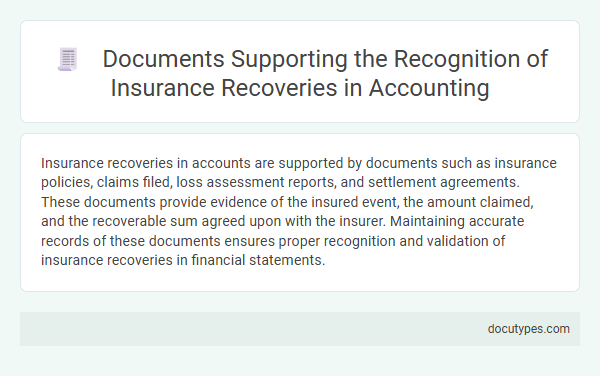Insurance recoveries in accounts are supported by documents such as insurance policies, claims filed, loss assessment reports, and settlement agreements. These documents provide evidence of the insured event, the amount claimed, and the recoverable sum agreed upon with the insurer. Maintaining accurate records of these documents ensures proper recognition and validation of insurance recoveries in financial statements.
Overview of Insurance Recovery in Accounting
Insurance recoveries refer to compensation received from insurance claims related to business losses or damages. Proper recognition of these recoveries in accounting requires specific supporting documentation to ensure accurate financial reporting.
- Insurance Policy - Details the coverage terms and conditions that validate the entitlement to recoveries.
- Claim Submission Documents - Include claim forms and correspondence that initiate the recovery process with the insurer.
- Settlement Agreement - Represents the insurer's confirmation of payment amounts and terms for the recovery.
Key Documents Required for Insurance Claims
Accurate recognition of insurance recoveries in accounts relies heavily on specific supporting documents. These key documents validate the claim and ensure proper accounting treatment.
- Insurance Policy - Details the coverage terms and conditions that justify the claim amount.
- Claim Notification - A formal document submitted to the insurer initiating the recovery process.
- Settlement Agreement - Confirms the agreed compensation between the insurer and the insured, supporting the recognized amount.
These documents collectively provide the necessary evidence to accurately record insurance recoveries in financial statements.
Policy Contracts and Coverage Details
| Document Type | Description | Role in Recognizing Insurance Recoveries |
|---|---|---|
| Policy Contracts | Official agreements between the insurer and the insured outlining the terms, coverage limits, exclusions, and obligations of each party. | Serve as the primary proof of coverage, validating the entitlement to insurance recoveries. They establish the basis for claim recognition in accounts by defining the insured risks and conditions for compensation. |
| Coverage Details | Specific information related to the extent and scope of coverage within the insurance policy, including endorsements and riders. | Clarify the scope of recoverable amounts and conditions. These details ensure accurate accounting by specifying which losses are covered and the limits applicable, facilitating precise recovery recognition. |
You should maintain these documents meticulously to support the accurate recognition of insurance recoveries in your financial accounts.
Notification and Claim Submission Documents
Insurance recoveries in accounts require proper documentation to ensure accurate recognition. Notification and claim submission documents serve as primary evidence supporting the recovery process.
Notification documents provide formal communication of the loss or damage to the insurer, establishing the basis for the claim. Claim submission documents include detailed information about the loss, supporting evidence, and the requested compensation amount. These documents collectively validate the entitlement to the insurance recovery, facilitating correct accounting treatment.
Adjuster’s Reports and Assessment Papers
Accurate recognition of insurance recoveries in accounts relies heavily on thorough documentation. Adjuster's Reports and Assessment Papers provide essential evidence to support and validate these recoveries.
- Adjuster's Reports - Detailed accounts from insurance adjusters documenting the extent of loss and the estimated recovery amount.
- Assessment Papers - Official evaluations that quantify damage and establish the financial basis for insurance claims.
- Supporting Evidence - You must ensure these documents are complete to substantiate the insurance recovery entries in financial records.
Correspondence with Insurance Providers
Correspondence with insurance providers plays a crucial role in supporting the recognition of insurance recoveries in accounts. These documents include claim approval letters, settlement agreements, and detailed communication confirming the amount recoverable. You should maintain this written evidence to ensure accurate financial reporting and compliance.
Loss Assessment and Valuation Reports
Loss Assessment and Valuation Reports play a crucial role in supporting the recognition of insurance recoveries in accounts. These documents provide detailed evaluations of the insured loss, establishing a reliable basis for the recovery amount. To accurately reflect insurance recoveries, your accounting records should include these comprehensive reports as key evidence.
Settlement Agreements and Payment Receipts
Settlement agreements serve as critical documents in recognizing insurance recoveries in accounts by clearly outlining the terms and amounts agreed upon for compensation. These agreements provide legal proof that supports the entitlement to recoveries and justify their recording in financial statements.
Payment receipts further validate the insurance recoveries by confirming the actual receipt of funds from the insurer. You should retain these receipts as evidence of payment, ensuring accurate recognition and reconciliation in your accounting records.
Disclosure Requirements under Accounting Standards
Insurance recoveries must be recognized in accounts based on clear evidence of entitlement and reliable measurement, as outlined in accounting standards such as IFRS and GAAP. Key documents supporting this recognition include the insurance policy, claim forms, correspondence with the insurer, and settlement agreements.
Disclosure requirements emphasize transparency regarding the nature, timing, and amount of insurance recoveries. Your financial statements should include detailed notes explaining these recoveries to ensure compliance and provide stakeholders with a clear understanding.
Which Documents Support the Recognition of Insurance Recoveries in Accounts? Infographic

